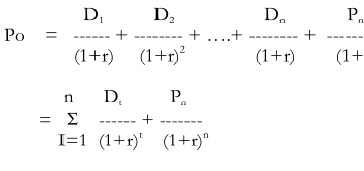Since equity shares have no maturity period, they may be expected to bring a dividend stream of infinite duration.
Hence the value of an equity share will be

Where
Po = price of the equity share today
D1= dividend expected a year hence
D2 = dividend expected 2 years hence
D¥ = dividend expected at the end of infinity
r = expected return
An investor who plans to hold it for n years and sell it therefore for a price of Pn will get his equity share having a value.

For practical applications it is helpful to make simplifying assumptions about the pattern of dividend growth as follows:
- The dividend per share remains constant forever, implying that the growth rate is nil (the zero growth model)
- The dividend per share grows at a constant rate per year forever ( the constant growth model)
- The dividend per share grows at a constant extraordinary rate for a finite period, followed by a constant normal rate of growth forever thereafter .
- The dividend per share, currently growing at an above normal rate, experiences a gradually declining rate of growth for a while. Therefore, it grows at a constant normal rate

